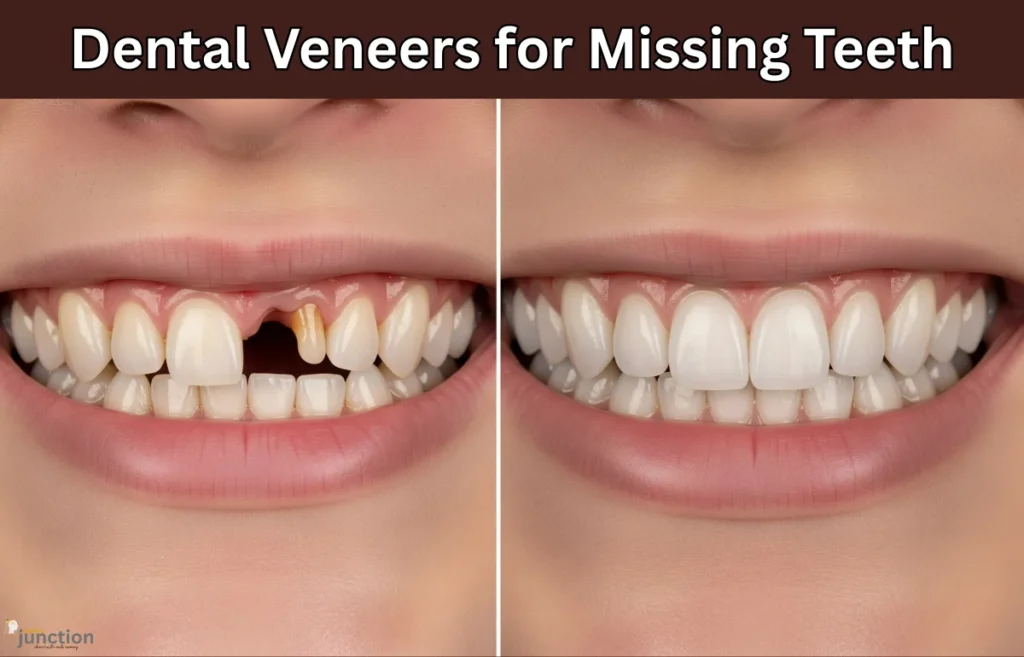When it comes to improving your smile, dental veneers for missing teeth might sound like a quick fix—but can they really replace a tooth that’s no longer there? Veneers are known for transforming chipped, discolored, or misshapen teeth, but their role in dealing with missing teeth is more nuanced. In this guide, we’ll explore what veneers can and can’t do, alternative solutions, costs, procedures, and expert recommendations so you can make the best decision for your smile.
Understanding Dental Veneers
What Are Dental Veneers?
Dental veneers are thin shells—usually made of porcelain or composite resin—that are bonded to the front of your natural teeth. They mimic the color, texture, and shine of real enamel, making them a popular choice for cosmetic dentistry. Veneers can:
-
Hide discoloration and stains
-
Correct minor gaps and misalignments
-
Improve the shape and size of teeth
-
Strengthen slightly damaged enamel
However, veneers need a natural tooth structure to attach to—which means they cannot directly replace a missing tooth.
Can You Use Dental Veneers for Missing Teeth?
Here’s the truth: dental veneers alone cannot fill an empty space where a tooth is missing because there’s no tooth for them to bond to. However, dentists sometimes use veneers in combination with other restorative treatments to create a uniform smile.
When Veneers May Be Used Around Missing Teeth:
-
To ensure uniformity with adjacent teeth after a bridge or implant has been fitted.
-
To close small gaps caused by minor spacing issues (not actual tooth loss)
-
To enhance the appearance of neighboring teeth so they blend seamlessly with a prosthetic replacement
If you’re missing a tooth, you’ll likely need a dental implant, bridge, or partial denture as the base solution. Veneers can then be added to adjacent teeth for a flawless look.
Alternative Treatments for Missing Teeth
| Treatment Option | Best For | Longevity | Aesthetic Quality | Cost Range (USD) |
|---|---|---|---|---|
| Dental Implant | Permanent tooth replacement | 15–25 years or more | Excellent, natural look | $3,000–$5,000 per tooth |
| Dental Bridge | Missing 1–3 teeth in a row | 10–15 years | Good, blends with smile | $1,500–$3,500 |
| Partial Denture | Multiple missing teeth | 5–10 years | Good, but removable | $600–$2,500 |
| Veneers (Adjacency) | Cosmetic enhancement next to replacement | 10–15 years | Excellent | $800–$2,500 per tooth |
Source: American Dental Association, 2024.
How Veneers Work with Other Restorations
1. Veneers and Dental Implants
After getting an implant to replace a missing tooth, veneers can be added to neighboring teeth to create a consistent color and shape for your smile.
2. Veneers with Dental Bridges
If a bridge replaces a missing tooth, veneers can help adjacent teeth match the bridge perfectly, creating a seamless look.
3. Veneers for Minor Gaps
For small gaps where no tooth is missing, veneers can reshape existing teeth to close the space.
The Process of Getting Veneers (When Applicable)
Even if you’re not replacing a tooth directly with a veneer, the process is similar when they are used for adjacent teeth:
-
Consultation – Your dentist examines your smile, discusses your goals, and determines if veneers are suitable.
-
Tooth Preparation – A thin layer of enamel is gently shaved off the tooth’s surface to accommodate the veneer.
-
Impressions – A mold of your teeth is taken to craft custom veneers.
-
Temporary Veneers – If necessary, temporary veneers are used to shield your teeth while the permanent ones are being prepared.
-
Bonding – Permanent veneers are attached with dental cement, then adjusted for comfort and appearance.
Pros and Cons of Using Veneers in Missing Tooth Cases
Advantages:
-
Enhances the appearance of surrounding teeth
-
Provides a natural, bright look
-
Long-lasting with proper care
-
Can be combined with other treatments
Limitations:
-
Cannot replace a tooth on its own
-
Irreversible (requires enamel removal)
-
More expensive than basic cosmetic options like bonding
-
Not suitable if you have severe gum disease or major oral health issues
Cost Considerations for Dental Veneers for Missing Teeth
The cost of dental veneers for missing teeth scenarios depends on:
-
Material (Porcelain is pricier but more durable than composite)
-
Number of veneers needed
-
Additional treatments (implants, bridges, whitening)
-
Dentist’s expertise and location
Since veneers in these cases are often cosmetic, insurance may not cover them. However, restorative work like implants or bridges might be partially covered.
Caring for Veneers and Restorations
To extend the lifespan of your veneers and nearby restorations:
-
Brush twice daily with non-abrasive toothpaste
-
Floss gently around veneers and implants
-
Avoid chewing hard objects like ice or pens
-
Wear a nightguard if you grind your teeth
-
Visit your dentist every 6 months for check-ups
With proper maintenance, porcelain veneers can endure for 10 to 15 years, and in some cases, even longer.
Expert Insights
Dentists emphasize that veneers should be viewed as a cosmetic enhancement, not a tooth replacement. According to the American Academy of Cosmetic Dentistry, the best approach for a missing tooth is a functional replacement (like an implant or bridge), followed by cosmetic work to achieve symmetry and aesthetics.
This means veneers can still play a supporting role—helping blend artificial teeth with natural ones for a flawless smile.
FAQs on Dental Veneers for Missing Teeth
Conclusion: The Right Approach for a Complete Smile with Dental Veneers for Missing Teeth
While dental veneers for missing teeth can’t replace the tooth itself, they are an excellent option for perfecting your smile after restorative work like implants or bridges. Think of them as the final polish—enhancing symmetry, brightness, and overall beauty.
If you’re dealing with a missing tooth, the best first step is to consult a qualified dentist who can recommend the right restorative treatment. Once your tooth replacement is in place, veneers can help ensure your smile looks as good as it feels.
Next Step: Schedule a consultation with a dentist to discuss your options and develop a personalized smile plan.
Learn About Drinking Pineapple Juice Before Wisdom Teeth Removal

I’m Salman Khayam, founder of Wellbeing Junction. I synthesize trusted information from research and expert guidance to create clear articles across health, wellness, and lifestyle topics.
Disclaimer: Content is for informational purposes only and is not medical advice. Consult a qualified expert regarding personal health or specialized questions.


